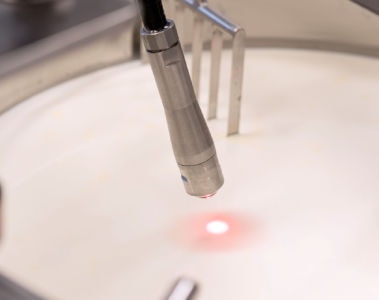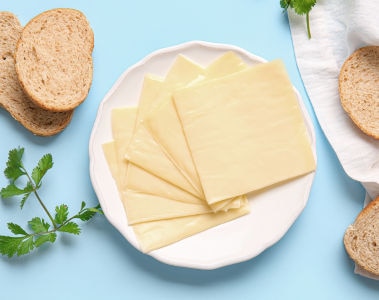
News
3月 25, 2024
チーズの味と食感における培養と凝固剤の役割
特定の市場にアピールするために、適切な風味とテクスチャーを持つチーズを製造するには、チーズメーカーは適切な培養物、補助剤、凝固剤を選択することが不可欠である。
To produce cheeses with just the right flavor and texture to appeal to very specific markets, it’s vital that cheesemakers select the right cultures, adjuncts and coagulants.
Choosing the right coagulant for the right texture
For pasta filata, Cheddar, and continental cheeses such as Gouda and Maasdam, texture, sliceability and shredability are key characteristics, as they can have important consequences on productivity and profitability. These textural traits are heavily influenced by proteolytic activity and a homogenous moisture distribution in the cheese.
Adding a coagulant with a low proteolytic activity – such as a coagulant enzyme that is highly specific towards k-casein and α-casein – to the production process, leads to a cheese with improved texture and moisture distribution, as well as better sliceability. This can result in 15% less waste during slicing. Improved sliceability also allows cheesemakers to increase the water content of a cheese by up to 2%, further increasing the quality of the final product. The economic gain achieved by improving the yield over the entire production run will impact the cost-effectiveness of the cheese production plant significantly.
Flavor also depends on choice of coagulant
Coagulant enzymes also play a key role in the flavor development of cheese. Firstly, they support cheese ripening by cutting the α-caseins to increase accessibility of the enzymes of the lactic acid bacteria; a process that aids the development of flavor. Secondly, specificity in cutting casein also helps to improve taste. This is because the right coagulant prevents the hydrolysis of β-caseins during ripening, avoiding the development of a bitter off-flavor taste.
The role of a culture in flavor development
The type and dosage of the culture used during the cheese development process are important in determining the final taste of a cheese. Cheese cultures have two functionalities. Their acidifying properties decrease the pH scale in a product and thereby affect the taste and texture of the cheese. Cultures also help to further develop taste components by breaking down available sugars (such as lactose and galactose) and proteins, which impacts taste, texture and therefore the characteristics of the final cheese. Both aspects are closely connected.
dsm-firmenich helps cheesemakers optimize texture and taste
dsm-firmenich provides cultures and coagulants to help cheesemakers worldwide produce cheeses with just the right texture and flavor to appeal to their very specific markets. Our Delvo® Cheese and Ceska®Star starter cultures help dairy manufacturers optimize cheese production while improving cheese flavor, texture and quality. Our Flavor Wheel™ with the Ceska®Star and Delvo®ADD adjuncts enable cheese producers to achieve distinctive and delicious flavor and/or texture profiles.
dsm-firmenich also offers a full vegetarian coagulant product range that has VLOG, Kosher, Halal and benzoate-free status. Within this range, our new Milase® Premium enables producers to maintain texture and flavor stability in traditional and low-fat Gouda and Maasdam cheeses throughout shelf life, while also preventing any off-notes in matured cheese. Characteristics of this rennet closely resemble the quality obtained with traditional chymosin products.
To meet stringent cheese quality requirements, dsm-firmenich’s Fromase® range of vegetarian coagulants obtains the golden standard for large-scale economic and consistent production of cheese. It offers the purest microbial rennet on the market, with high thermolability for an optimal whey value.
Finally, our Maxiren® range of vegetarian-specific fermentation-produced chymosin (FPC) coagulants – 100% pure chymosin enzymes produced by fermentation – offers proven performance in meeting needs without negatively impacting taste or texture. In particular, Maxiren® XDS delivers the highest yield, unique whey quality and superior slicing performance in the industry, while increasing moisture by up to 2,0 % and maintaining cheese quality.
特定の市場にアピールするために、適切な風味とテクスチャーを持つチーズを製造するには、チーズメーカーは適切な培養物、補助剤、凝固剤を選択することが不可欠である。
適切な食感に適切な凝固剤の選択
パスタ・フィラータ、チェダー、そしてゴーダやマースダムなどのコンチネンタルチーズにとって、テクスチャー、スライス性、細断性は、生産性と収益性に重要な影響を及ぼす可能性があるため、重要な特性である。 これらのテクスチャー特性は、タンパク質分解活性とチーズ内の均質な水分分布に大きく影響される。
k-カゼインやα-カゼインに特異性の高い凝固酵素など、タンパク質分解活性の低い凝固剤を製造工程に加えることで、チーズの食感や水分分布が改善され、スライス性が向上する。 その結果、スライス時の廃棄物が15%減少する。 また、スライス性が向上することで、チーズメーカーはチーズの水分含量を最大2%増加させることができ、最終製品の品質をさらに向上させることができる。 製造工程全体の歩留まりを向上させることで達成される経済的利益は、チーズ製造工場の費用対効果に大きく影響する。
風味は凝固剤の選択にも左右される
凝固酵素は、チーズの風味開発においても重要な役割を果たしている。 第一に、α-カゼインを切断して乳酸菌の酵素の利用しやすさを高めることにより、チーズの熟成をサポートし、風味の開発を助ける。 第二に、カゼインを切断する際の特異性は、風味の改善にも役立つ。 これは、適切な凝固剤が熟成中のβ-カゼインの加水分解を防ぎ、苦味のある異味の発生を避けるためである。
風味開発における文化の役割
チーズの最終的な味を決定する上で、チーズの製造工程で使用される培養物の種類と量は重要である。 チーズ培養物には2つの機能性がある。 その酸性化特性は、製品のpHを低下させ、それによってチーズの味と食感に影響を与える。 また、培養物は、利用可能な糖(乳糖やガラクトースなど)やタンパク質を分解することによって、味覚成分をさらに発達させるのに役立ち、味、食感、したがって最終的なチーズの特徴に影響を与える。 この2つの側面は密接に関連している。
DSM社、チーズメーカーの食感と味の最適化を支援
DSMは、世界中のチーズ製造業者が、それぞれの市場に適した食感や風味を持つチーズを製造できるよう、培養液や凝固剤を提供しています。DSMのDelvo® Cheese およびCeska®Star スターター培養液は、乳業メーカーがチーズの風味、食感、品質を向上させながら、チーズ製造を最適化できるようサポートします。DSMのFlavor Wheel™とCeska®StarおよびDelvo®ADD 補助剤は、チーズ製造業者が特徴的でおいしい風味や食感のプロファイルを実現することを可能にします。
DSMはまた、VLOG、コーシャ、ハラール、安息香酸塩フリーのベジタリアン向け凝固剤製品も提供している。この製品群の中で、DSMの新しいMilase® Premium 、生産者は伝統的なゴーダチーズや低脂肪ゴーダチーズ、マースダムチーズの食感と風味の安定性を保存期間中維持し、熟成チーズの異臭を防ぐことができる。 このレンネットの特徴は、従来のキモシン製品で得られる品質に酷似している。
厳しいチーズの品質要求に応えるため、DSMのベジタリアン用凝固剤Fromase® シリーズは、大規模で経済的かつ安定したチーズ製造のためのゴールデンスタンダードを獲得しています。 市場で最も純粋な微生物レンネットを提供し、最適なホエー価値のための高い熱溶解性を備えています。
最後に、Maxiren® のベジタリアン向け発酵生成キモシン(FPC)凝固剤(発酵によって生成される100%純粋なキモシン酵素)シリーズは、味や食感に悪影響を与えることなく、ニーズを満たす実証済みの性能を提供します。特にMaxiren® XDSは、水分を最大2.0%増加させ、チーズの品質を維持しながら、業界で最も高い歩留まり、ユニークなホエー品質、優れたスライス性能を実現します。
詳細は?
コンチネンタルチーズ、モッツァレラチーズ、チェダーチーズ、カッテージチーズ、ホワイトチーズ、スイスチーズのいずれを製造する場合でも、DSMの専門家が適切なスターターカルチャー、補助食品、凝固剤のサンプルを喜んで提供いたします。 詳しくは専門家( )までお問い合わせください。

フード・ファクト
調査によると、適切な凝固剤を選択することで、チーズの製造工程全体で二酸化炭素排出量を3.5%削減できる。1
Food Fact
Research indicates that selecting the right coagulant can lead to a carbon footprint reduction of 3.5% across the total cheese production process.1

